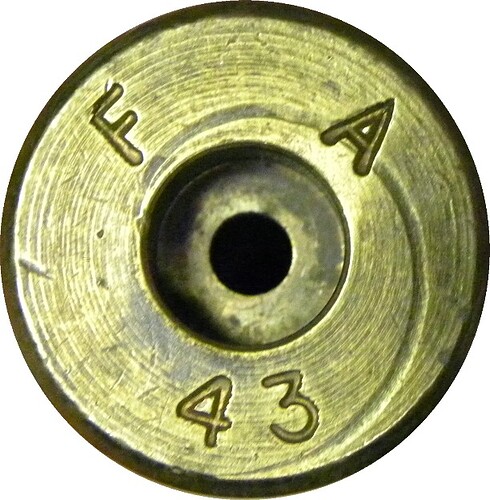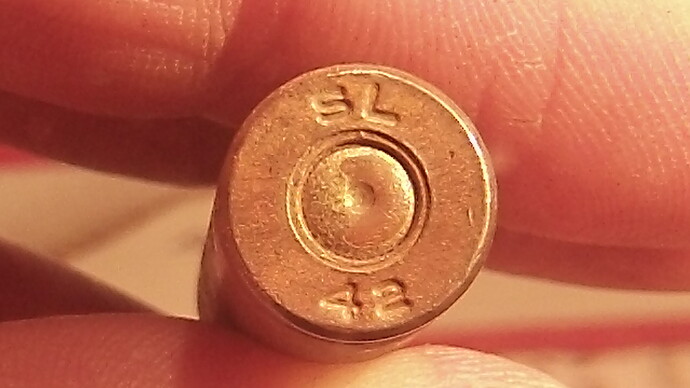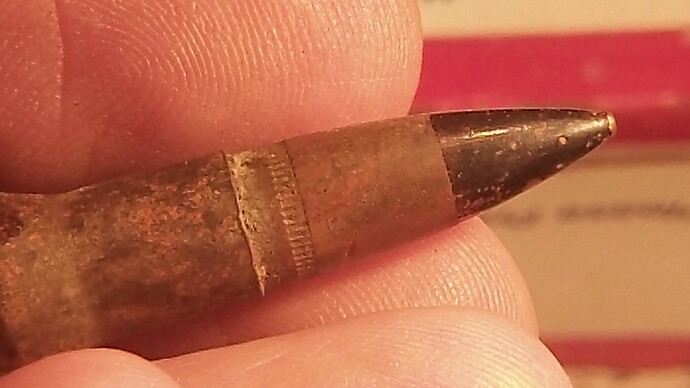Hi navyson, no problem in asking, I’ll give you a clue, “rugby”
Hi Nickfresh, I think so:)
Uh-oh. If that’s as you found that, then I’d suggest checking the law very rapidly and probably getting shot of it. They tend to throw the book at people in possession of firearms and/or ammunition over here, even if they’re just collecting old WW2 stuff. If it’s deactivated you’re probably OK though, but I’m not sure…
Thanks for letting me know, yes, you always got to be care-full with ammo, this one has a hole where the firing pin strikes, and the actual bullet is loose, and the case is broken, I don’t know about being a deact, would they have deact certificate’s for rounds.
If you can wiggle the bullet out, dump any powder there may be inside. The lawn is a good place, powder makes a good fertilizer, sprinkle it around. You say there is a hole in the case head, do you mean that there is no primer at all? If no primer, and no powder, it may be easier for you to keep it. I will caution you about the bullet, as most all service .50 BMG bullets were both armor piercing, and incendiary. This being a small charge of flash powder in the tip of the jacket in front of the penetrator. If anything at all,the only thing to indicate its presence, is some paint on the tip of the bullet(colors vary) this could easily disappear over time in the ground. Someone here may know for sure if the bullets of that time had the incendiary charge. The pic is of a case with no primer.
Sounds to me like it’s actually a fired case plus a loose bullet (possibly also fired - any rifling marks?). If so, then it clearly isn’t a round of ammunition and the police won’t be interested. At least that would be my story and I’d be sticking to it 
Cant see any rifling marks, probably a dropped round that’s been broken?, don’t know if the American round had cordite or black powder, photo of some of my 303, training rounds, just posted, and the photo comes out small?, the charge on the left have wooden bullets, the other have holes drilled into cases.
Thank you for your help, The bullet can fall inside the shell, and with a pull, can come out, are you saying then, do not touch the bullet, has it may have incendiary powder still left on it, if I had to say a colour, it would be copper/brass.
It may well be just plain ball ammo, I did some looking, and ball ammo was manufactured for some uses. If it were an incendiary round, it would take a purposeful hammer blow to set it off. (no fusing, just an impact thing) So as long as you don’t go beating on it it should be fine. Propellant powders for the .50 were of the typical smokeless types, some of which can still be purchased today for hand loading one’s own .50 BMG ammo. No Cordite, or Black Powder was used. Cordite could be used, it was used in the .55 cal. Boys Rifle ammo. (one can use 50 BMG cases in a Boys, if they are necked up to .55 from .51 ) Black powder would not produce enough pressure, and quickly foul the gun.
Hi Chunky! Just curious, flamethrowerguy is from Germany, and they find all kinds of stuff over there. Even 500-1000 lb. bombs!
P.S. Nickdfresh gave it away!
Hi tankgeezer
Not into ammo in a big way really, just picked a few up as they come along, my main interest has been with WW1 British Army, now into WW2, British and American Armies. got to do something to keep the old brain ticking over;), I do have a couple or 18pdrs and 25pdrs, and one “I think” a amour piercing 25pdr, don’t worry they are all safe:evil:
Chunky
Hi navyson
Go to France and Belgium driving, and you could many years ago, find relics laying around, well not always just laying:evil: never been to Germany,
I used to have an artillery round collection,even had an example of a fired 8" howitzer round. (a dug up from a testing range. ) it was filled with wax, and still weighed around 200 lbs. As time went by people just kept offering me good sums of money for them, so they are all gone now. Its a great hobby, more interesting than stamps, and just as varied. People in my area occasionally find shells, and round shot from the Civil War, buttons, and bullets too.
,
,
I use to collect stamps:(:), I sold some of my WW1 items off, sometimes for good money and some not for good money, still got some good items left thought, 100th Anniversary next year, hoping to put on a exhibition, once found a toffee apple mortar by Serre Road Cemetery, it was by the side of the road, parked the in front of it, I give it a little kick, not much of one:evil:. found lots of shrapnel balls, spent empty cases, some still with cordite, take a strand out and light it, its like a sparkler, spent 18pdrs shells, two badges, and what’s left of a 303 SMLE, which when out there, made sure it was safe, all this was a good few years ago now, tend now to just visit. I’m taken photo of my 25 and 18 pdr later, will try and post them, in new topic.
The thing with collectible objects like stamps, currency, Art, tools, and weapons, is that they usually represented the best their respective societies had to offer at the time. That provides a unique snapshot of what humanity was up to, and who they really were as a People. To me anyway, things made by the hand of a People say more about them than what may be found written in History books. (which are also important.)
You could say that collectors like us, in a small way, keep history alive, I’ve been collecting for a long time, and met many a friends in doing so.
I have as well found a head stamped SL 42, however it clearly is a 30-06 round. One thing puzzles me, the tip is painted black, is this some kind of early armor piercing round?
Hi Archaeodigger
Thank you for your help on this, see Originally Posted by tankgeezer; (Quote; also produced the .30 cal rifle cartridge (30-06)), not sure of the black tip though,
Chunky
The black tip paint did denote a hard Steel cored armor piercing bullet. This tip color was used on all A.P. ammo up to .50BMG into the 70’s,(perhaps to the present day) including the 5.56x45 round of the M-16. (although at some point this was changed to a green tip, no idea why though.)
U.S. markings from the 30’s to the 70’s was pretty much Black= armor piercing,
Red = trace
Silver = Incendiary
These marks may be combined if the round incorporates more than one feature. Ammunition made for other Nations would have their own marking system applied. With the advent of NATO, munitions, and their markings began to be standardized.
Hi tankgeezer, Thank you for posting this extra information, and I hope you didn’t mind me using you Quote. Chunky
Its perfectly okay to quote my posts Chunky, no problem at all.



